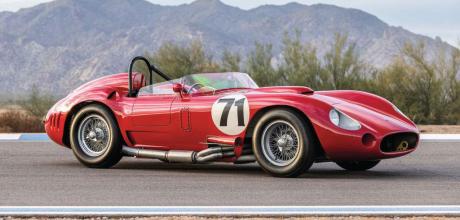1957 Maserati 450S
Even Stirling Moss was wary of the Maserati 450S. So Marc Sonnery takes the wheel of this car with a due sense of trepidation.
Photography Nick Lish
MODENA’S MIGHTIES WEAPON — Driving the monster that scared Stirling Moss
MONSTER MASERATI 450S
THE RACER THAT SCARED STIRLING MOSS
The 450S was Maserati’s endurance racing zenith – and also its Icarus moment. Even the late Sir Stirling Moss responded with a silent scream when I told him that I wanted to drive one. That was 24 years ago, and my memory of his vivid reaction serves as a sobering reminder of its reputation. The 450S was a bit of a beast.
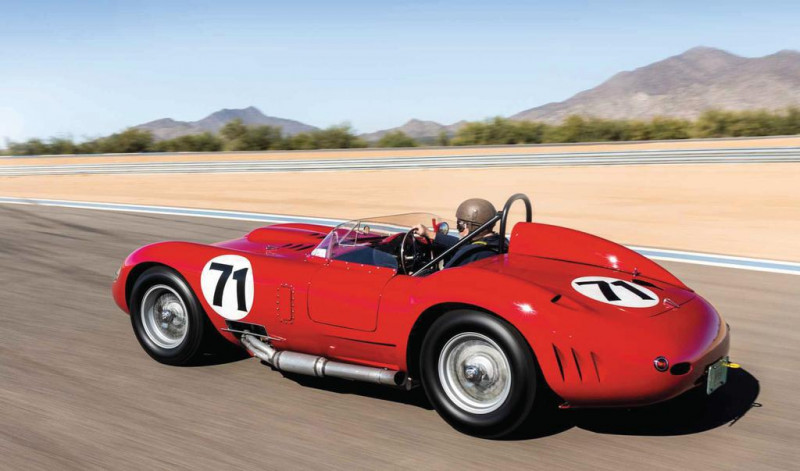
Thankfully our location today is not a slimy, leaf-strewn, autumnal Oulton Park but the Apex Motor Club, south of Phoenix in the Arizona desert, an excellent facility with smooth, dry tarmac. There it sits, combining beauty and brawn in its curvaceous Fantuzzi body, the Cibié headlights hungry for the Mulsanne straight. The engine bay is uncluttered, a big lump topped by huge Weber 45IDM velocity stacks. In the trunk, the beautifully crafted alloy fuel tank rests above the hefty diff, itself straddled by the single transverse leaf spring and a slender anti-roll bar. The massive finned brake drums sit just inboard.

I stand on the driving seat and slide down. The driving position is vertical, all the better for working the car – you would not want to lean back, this is not a fingertip-steered macchina. I’m glad the central throttle requested by its first owner was long ago replaced by a standard layout. The gearlever sits to your left in a beautiful chromed gate with notches not too deep and first upper left; a safety lever prevents accidental selection of reverse. The dashboard is beautifully simple, from left to right the chassis plate and three Jaeger gauges: oil pressure, revs, water temperature. Then comes the ignition key and, to the far right, the all-important distributor and magneto switch.

With lap-belt on, it’s time to start. You switch on distributor and magneto, wait for the fuel pump, prod the throttle a couple of times, push the ignition key in and the mighty roar erupts. The multidisc clutch is a challenge at first, the steering is beefy and even at low speeds the sheer power and torque make themselves known. Oh, and the huge brake drums pull all over the place when cold. Speed builds and, thankfully, so does confidence.
The gearchange is hefty yet a delight for upshifts, and when pulling high revs down the back straight the V8 bellows as though enraged, catapulting you down the tarmac. Braking for corners still has the 450S squirming but thankfully the gearshift is bolt-like, allowing fast throttle blips as you go down the ratios. Not that you need to shift a lot with that colossal torque, as you find on the way out of the corner and get back on the power. This time the back end starts coming out as if, well, as if this is Oulton Park on wet leaves. So you lift a bit to let it settle and, once straight, it sticks as you storm down the fast esses, quite composed.
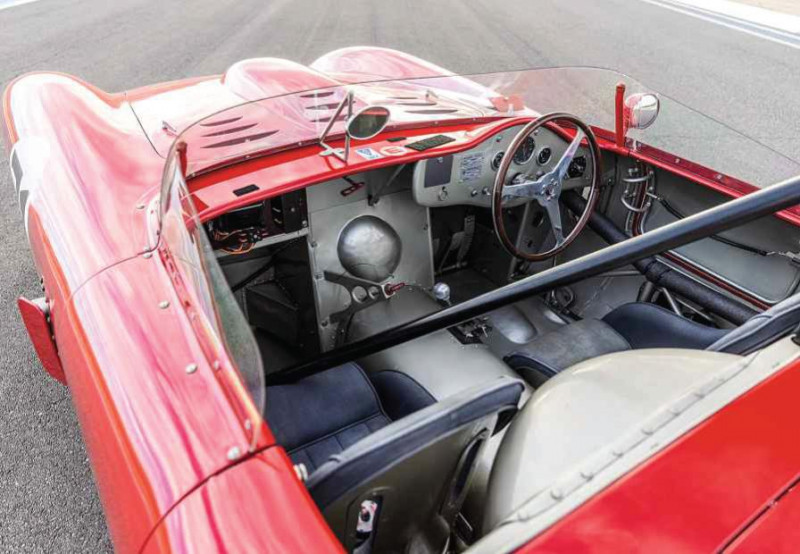
Out of a second-gear hairpin the back wheels are eager to expedite the process and have you facing the wrong way. But no, a bit of a lift and on your way you go. It is not agile, as such; you have to work it through, though as the car’s mechanical crew observed, the torque curve is flat between 4500 and 5500rpm, providing lightning-fast corner exits.
Along the back straight again, you give it even more revs… and off you go like a jet from an aircraft carrier. Hanging on for dear life, it feels like 140mph yet with the short straight and very short gearing it is in fact only 100mph. But what a raw 100mph! At high revs the gearbox whine is so loud that it competes for decibels with the engine; to imagine this missile tackling the Mille Miglia’s Adriatic coast straights at 190mph is mind-boggling.
Thankfully, as the laps multiply, so the drums warm and don’t pull as much. It is honest, fair and straightforward in its actions. An ethical opponent, you might say. Respect the 450S, stay away from foolish errors and it retracts its jaws. Top drivers in its day used to throw it into corners and power out, as the talented David Swig (who has raced chassis 4504 very effectively for its owner) confirms: ‘It just didn’t want to turn in at all. It reacted best if I adopted a “dirt track” driving technique: pitch in, slide out.’
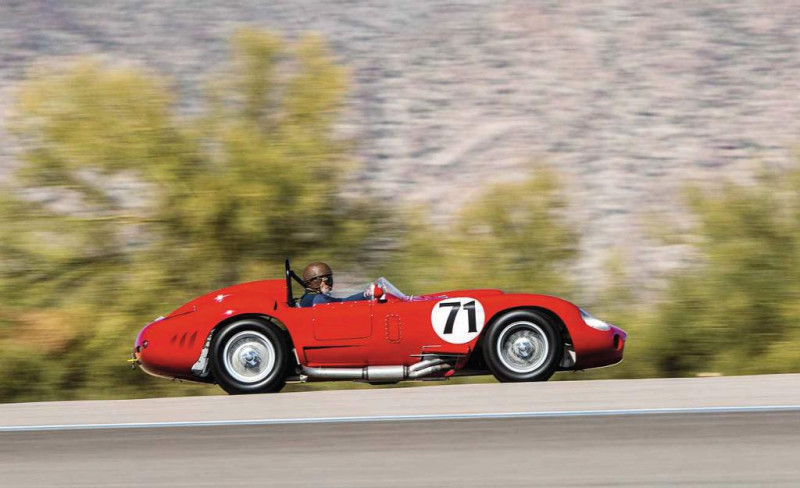
That said, you have to stay committed through the turn: if not and you lift mid-slide – as David once did – it will plough straight on: ‘A reminder that these are fearsome cars and will bite you if you are not careful.’ Drivers such as Behra, Fangio, Jim Hall and the dirt sprint racer Lloyd Ruby loved taking the 450S by the scruff of the neck; others, including Sir Stirling, did not. With due respect and caution, I had danced with the 450S and lived to tell the tale.
Which now follows. The genesis of Maserati’s Tipo 54 was protracted. It began in 1954 while Maserati was preparing the 300S and felt a bigger weapon would be needed in future for outright wins, but paused when the 1955 Le Mans tragedy brought uncertainty to sports car racing. Work resumed, prompted by USA-based Tony Parravano’s desire for a 4.2-litre Indianapolis engine, though that was stillborn. A V8 was taking shape, however: four gear-driven camshafts atop a 90º block with an initial capacity of 4477cc, offering plenty of scope for more. Hairpin valve springs were used, along with clever roller cam followers. A hefty chassis was prepared, with double wishbones at the front and a transverse leaf spring over the rear de Dion axle. The brand new, heavy-duty gearbox was designed in-house by Valerio Colotti and mounted in-unit with the differential. Then dyno testing began in the spring of 1956 – and the motor almost shook itself apart.
Ingegnere Giulio Alfieri, then 32, was the newly hired young blood eager to impress and assert himself, but he ran into conflict with Maserati’s engineering establishment: both Colotti and Guido Tadeucci. Ermanno Cozza, back then a technician, says: ‘Adolfo Orsi, the president of Maserati, had given Alfieri freedom of operation. However, in the technical office both Colotti, in charge of chassis and gearbox development, and Tadeucci, in charge of engine development, benefited from the owners’ trust and esteem. Like in all families there was friction between the two and Ingegnere Alfieri, whom they did not consider sufficiently qualified and whose interference in their projects they did not tolerate. There had already been tension between Colotti and Alfieri on 250F development.’
The firing order proposed by Alfieri did not allow the new V8 engine to run properly, so the old regime implemented a more traditional one, giving birth to an almightly powerplant, Maserati’s most powerful to that point. As Denis Jenkinson related, when it ran on the dyno, it could be heard far beyond the factory walls.
Cozza recalls: ‘Both Guerrino Bertocchi and Jean Behra, who happened to be at the factory, tested it a lot on the Autodromo and on the roads before it had its debut and could be tested by Fangio in the Swedish GP at Kristianstad.’
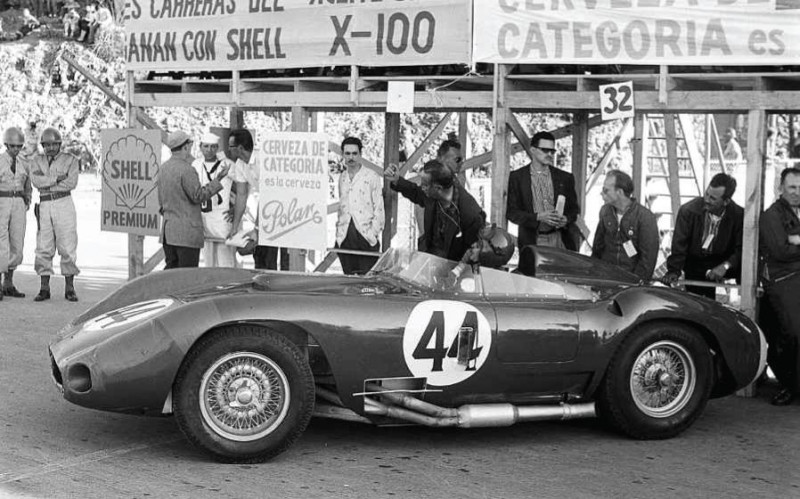
This wasn’t yet a fully developed 450S but a mongrel test car based on a modified 350S chassis and a 300S body with a crude bulge on the bonnet to make space for the new engine. With a ‘T’ for testing as opposed to a race number it ran only in practice, and all drivers, Fangio included, were impressed by its performance – except that the brakes were overwhelmed, so it could not be raced. The bonnet bulge also impeded proper air supply to the carburettors.
‘GIVE IT MORE REVS AND OFF YOU GO LIKE A JET FROM AN AIRCRAFT CARRIER’
Next came a bespoke chassis. Disc brakes were briefly considered before huge finned drums were adopted, too large to fit inside the rims. The body looked like a 300S that had taken up weight-lifting. Its race debut was in Buenos Aires in January 1957, where Moss and local hero Fangio co-drove. It barrelled into the distance, the opposition thoroughly winded and defeated. Then clutch failure and the strain of too many clutchless shifts caused its retirement.
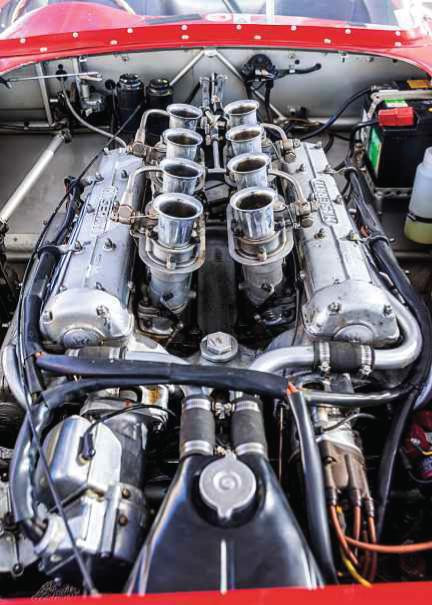
The 450S’s race career was dotted with pole positions, leads and fastest laps but plagued by mechanical breakdowns and, while repeated halfshaft failures cannot be blamed on bad fortune, the last round of the season in Caracas is probably the unluckiest race any team ever had. Present were three of the 450S: two factory cars and a Temple Buell entry driven by Masten Gregory and Dale Duncan. The factory also brought a 350S and 300S.
Moss took pole from Behra but struggled to get his 450S to fire up during the Le Mans start; likewise the 300S of Brooks. On lap two, after a demon start and taking the lead, Gregory nudged a sandbag and flipped his 450S, his life saved by a newly installed roll bar. Moss’s was taken out at high speed by an errant AC Bristol, and he walked back to the pits. Behra pitted the remaining car and it caught fire, burning Behra and chief mechanic Bertocchi, who had rushed forward with a fire extinguisher. Then Moss was put in the driving seat – the only part of the car still on fire, which had gone unnoticed by the team and fire marshals.

Moss pitted again minutes later and leapt out with pants burned, in pain, done for the day. Herry Schell took over and, just as he lapped Jo Bonnier’s 300S in a fast curve, the Swede had a puncture that sent him into the 450S, causing both to crash. The 450S was destroyed in the resulting fire, and with it Maserati’s title glory hopes. This disaster caused Maserati, bleeding money, to retire not only from endurance racing but also from F1: only clients would race its cars henceforth. The days of the 450S were also doomed in Europe as a 3.0-litre capacity became the upper limit.
And so it was that they would see further activity only in the USA, as in the case of our subject, chassis 4504. It was ordered new by the gentleman racer Jim Kimberly, heir to the Kimberly-Clark Kleenex fortune. Kimberly sent very specific requests, including seat measurements, a centre throttle, and a head restraint with a protective steel tube welded to the chassis. With these requirements executed, assembly was concluded weeks later, in May 1957.
Kimberly took delivery of the car at his summer home near Elkhart Lake’s recently finished Road America, making his debut in the June sprints. Weeks later for the Road America 500 he arranged for Jack McAfee to co-drive with him but transaxle problems in practice meant the car didn’t start the race. It car was shipped to Havana for the Cuban Grand Prix, but Kimberly felt the circuit was dangerous, had one too many scares in practice and wouldn’t go near the 450S again. Maurice Trintignant practised in it but felt something wasn’t right and the romance between Kimberly and 4504 was a short one. He could micromanage his driving position measurements but not its fierceness.
‘IN ITS POMP, NOTHING COULD TOUCH MODENA’S MIGHTIEST WEAPON’
With the car under subsequent ownership, Stirling Moss tested 4504 at Bridgehampton under the supervision of the team manager Alfredo Momo. They set the car up thoroughly for the Nassau races in December 1958, and there Eddie Crawford finished second overall in the Nassau Memorial Trophy.
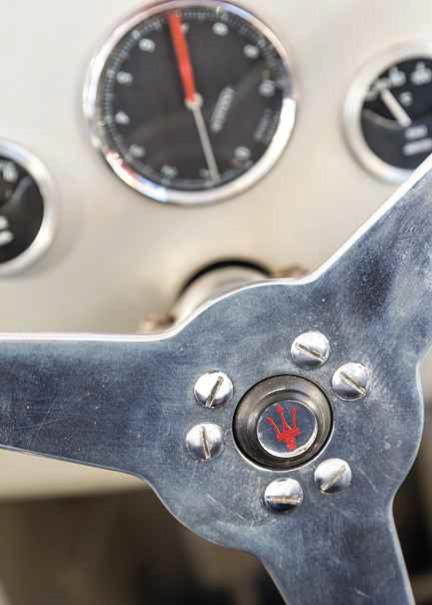
As happened to many obsolete racing cars, 4504 then fell into the wrong hands. Its engine was removed for a boat project that never came to fruition and it could easily have been lost and scrapped. This is where Maserati sleuth and author Joel Finn came in, reuniting 4504 with its engine. In 1986, it ended up with Luigi Mancini of Pisa, who took it home to Italy.
The engine was rebuilt and Carrozzeria Garuti began a restoration but, unfinished, the car went to Dragone Classic Motorcars in Connecticut, USA, in 1997. Houston-based collector Alfredo Brenner acquired it and finished the assembly, then 4504 passed to the current owner in 1999. Previous work had been carried out with concours in mind, whereas the new intention was to race it – very different priorities. And so the car was handed to McCabe Auto Restorations in Illinois for bodywork, under the supervision of the owner’s engineer, Dyke Ridgley.
Ridgley explains: ‘By careful study of historical photos, Skip McCabe and I found that both the nose and rear bodywork were wrong. We modified the “newly” restored front and rear sections of the car and were able to determine that the centre portions of the bodywork were original and correct. Using traditional Italian bodywork techniques, we managed to duplicate the proper, original shape of the Fantuzzi body.’
Scott Taylor of Crown Point, Indiana, took care of the drivetrain. The engine needed a full rebuild and, while the internals showed limited wear, parts such as the water pump impellers were corroded so bespoke replacements were machined. Each 450S was built with hairpin valve springs, though 4504 had at some point been converted to coil springs, which were left in place. Maserati’s engineers employed asymmetric cam timing, not via asymmetric cam lobes but by unique roller cam followers, which also reduce wear. The design of the rocker gives a different rate of opening versus closing, which Ridgley discovered by chance.
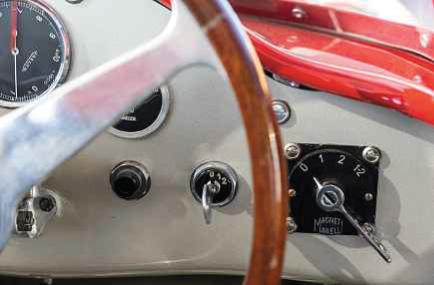
‘The crankshaft was another shock,’ he says. ‘We found it to be over 100g out of balance at each end! Maserati V8s of this period were known to “shake” and now we knew why. It has since been recorded by Mr Cozza, the factory historian, that for years their balancing machine was defective and they found out about it only when a new machine was purchased in the mid-1960s.’
A new crank was made, much stronger and lighter, likewise the conrods, and pistons that raised the compression ratio slightly. Fitting larger carburettor chokes and synchronising the advance curve of magneto and distributor resulted in a much smoother, more powerful engine. ‘When I dyno’d the engine, I was amazed by how smoothly it ran. It pulled like a train at high revs. The work with the crankshaft and conrods paid off. I have rarely seen a big V8 run so smooth, approaching 7000rpm.’
Scott Taylor rebuilt the transaxle, with new gears supplied by Crosthwaite & Gardiner, and a shock dyno perfected the damper set-up.
Adds Ridgley: ‘Initially the owner found the car to be very unpleasant. It was corner-weighted, the rear spring mounts made adjustable, then we fabricated a 13mm rear sway-bar for additional front-to-rear balance. It made a significant improvement, going from “horrible” to merely “difficult”.’
Today 4504 is one of only three 450s still to have its original engine. Of the ten cars and one prototype built, nine exist in some form. Looking back at that dramatic 1957 season, had the halfshaft problem been sorted, more victories could have made Maserati’s points tally sufficient to win the title – and a very different future than near-bankruptcy would surely have followed. The final blow came when a large order of machine tools by the Perón regime in Argentina was not paid for, despite Fangio’s best mediation efforts. Maserati was lucky to survive at all.
In its pomp, however, nothing could touch Modena’s mightiest weapon – until it came unstuck, like Icarus.
TECHNICAL DATA 1957 Maserati 450S
- Engine 4477cc V8, DOHC per bank, four Weber 45IDM carburettors
- Max Power >400bhp @ 7000rpm
- Max Torque 344lb ft @ 4600rpm
- Transmission Five-speed manual transaxle, rear-wheel drive
- Steering Worm and sector
- Suspension Front: unequal-length wishbones, coil springs, telescopic dampers, anti-roll bar. Rear: de Dion axle, transverse leaf spring, telescopic dampers, anti-roll bar
- Brakes All Drums
- Weight 1052kg
- Top speed 181mph
THANKS TO the owner, his support crew, Dyke Ridgley, Ermanno Cozza, Fabio Collina, Willem Oosthoek, Jean-François Blachette, Alan W, and the team at Apex Motor Club.
Above and right Not much in the way of switchgear or instrumentation on the 450S's simple dash; five-speed transaxle features an open gate; out on the track, the Maserati is no less intimidating than its reputation suggests.
Above and left Fantuzzi's styling is sublime 1950s racer perfection; first owner Jim Kimberly with 4504 in Havana for the 1958 Cuban GP, his last outing in the car.
Clockwise, from top left In its element on the track, but driving the 450S requires commitment; 4.5-litre quad-cam V8 now unleashes more than 400bhp; steering wheel is the focus of this workplace.


